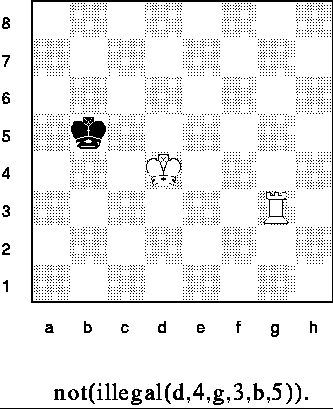Learning rules from chess databases

Contents and links
Early work on propositional learning from logic databases such
as those provided by chess endgames played a key role in highlighting
the easy-inverse trick which was later used in developing systems such as
Kardio [Bratko I., Mozetic I. and Lavrac N. (1989)]. These databases are good sources
of examples for both learning and testing rules.
In fact relatively simple chess problems
have in the past defeated Machine Learning systems which have otherwise
proved rather successful on a range of real-world tasks.
Recognising illegal positions
The data provided here concerns one such simple problem: that of the KRK endgame.
In this, there are three pieces left on the chess board: White
King, White Rook and Black King. The problem of
learning rules for recognising illegal positions when it is white's turn
to move (WTM) was first proposed by [Muggleton S.H., Bain M.E., Hayes-Michie J. and Michie D. (1989)]. This has since
become a widely accepted test-bed for ILP systems.
An example of an illegal position
is shown below:

This is illegal since BK:e1 is in check with WTM.
The following example, in contrast, shows a legal position:
 .
.
ILP systems usually use the following information to learn the concept:
- Examples are represented by the predicate
illegal/6. The
arguments of this predicate stand for the file (column) and rank
(row) coordinates for the WK, WR and BK.
- The background knowledge provided is simply the ordering of rows
or columns on a chess board. The predicate
lt/2 tabulates
pairs row or column values where one is less than the other.
The predicate adj/2 tabulates row or column values that
are adjacent.
Predicting optimal depth of win
Another, more difficult problem is to do with predicting optimal depth of
win (that is, the number of moves to checkmate). In the data here, the
exhaustive database for the KRK domain acts as a source of example positions,
each of which has associated with it optimal depth of win information.
Here this is represented by the predicate krk/7. The arguments for
this predicate stand for depth of win, and the file (column) and rank
(row) coordinates for the WK, WR and BK.
The typical ILP task is to learn the sub-concept
`black-to-move KRK position won optimally for white in N moves''.
Preliminary results of classifiers for ``won in 0 moves'' up to
``won in 5 moves'', can be found in
>[Bain M. and Srinivasan A. (1995)].
The background knowledge used consisted of ground instances of the predicates
``symmetric difference'' between files and ranks and
``strictly less than'' (&;lt;) for all unordered pairs of the file values
a...h and all unordered pairs of the rank values
1...8.
The data files are held in
one compressed TAR file, containing predicates
as described above. Within
the TAR file, they are as used in the original Golem
experiments. That is, background knowledge files have a ``.b'' suffix,
positive example files have a ``.f'' suffix, and negative example files
have a ``.n'' suffix.
Bibliography
Bain M. and Srinivasan A. (1995).
Inductive Logic Programming With Large-Scale Unstructured Data.
In D. Michie K. Furukawa and S. Muggleton, editors,
Machine Intelligence 14. Oxford University Press.
Bratko I., Mozetic I. and Lavrac N. (1989).
Kardio: a Study in Deep and Qualitative Knowledge for Expert Systems.
MIT Press, Cambridge Mass.
Muggleton S.H., Bain M.E., Hayes-Michie J. and Michie D. (1989).
An experimental comparison of human and machine learning formalisms.
Proceedings of the Sixth International Workshop on Machine Learning
Up to applications main page.
 Machine Learning Group Home Page
Machine Learning Group Home Page


 .
.
 Machine Learning Group Home Page
Machine Learning Group Home Page